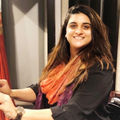Interviews
Smart textiles must be comfortable & reliable
28 Nov '08
5 min read
Optical fibres also offer a promising avenue for new smart clothing because of their potential flexibility and their capacity to use light both as an information carrier and a sensor in itself. The team behind the Ofseth project (see our feature article) is aiming at applications in oximetry – a clever non-invasive way to measure the oxygen content of blood
In a hospital setting, a clip is attached to a patient's finger measuring a ratio in the absorption of red and infrared light passed through a patient's finger, which varies depending on the state of oxygen-rich, bright red blood and oxygen-poor, dark red blood. Ofseth researchers hope to replicate the measure in clothing (without the need for the finger clip typically used in hospitals) by placing optical fibres around the neck of a smart garment.
In a related healthcare activity, the Mermoth project worked on integrating smart sensors, advanced signal processing techniques and new telecommunication systems on a textile platform.
Wet electronics
Biotex project is looking at the chemical monitoring of textiles, a new frontier in the emerging field of smart textiles. Most smart fabric applications want to stay dry, but Biotex is hoping to develop sensors that can measure body fluids like sweat, too. If they are successful, it will open up whole new areas for smart applications.
“Right now we're looking at sporting applications, because the medical applications are very difficult to bring to market and require enormous validation efforts to ensure reliability in a medical setting,” explains Luprano.
The Biotex system aims to measure the conductivity, electrolyte level, temperature and pH of the users sweat, all enormously useful indicators for sporting applications. The project also aims at monitoring wound healing by placing biosensors in contact with exudates present in wounds.
Clevertex is taking a big picture view of the field in its efforts to develop a strategic 'master plan' for transforming, by 2015, the traditional textile and clothing sector into a knowledge-driven industrial sector.
The projects in the SFIT cluster mean a double benefit for Europe's smart-clothing sector. The applications are useful in themselves, and the technical solutions developed in each project will benefit the range of smart-clothing systems.
The SFIT cluster and its associated projects received funding from the European Union's Framework Programme for research.
In a hospital setting, a clip is attached to a patient's finger measuring a ratio in the absorption of red and infrared light passed through a patient's finger, which varies depending on the state of oxygen-rich, bright red blood and oxygen-poor, dark red blood. Ofseth researchers hope to replicate the measure in clothing (without the need for the finger clip typically used in hospitals) by placing optical fibres around the neck of a smart garment.
In a related healthcare activity, the Mermoth project worked on integrating smart sensors, advanced signal processing techniques and new telecommunication systems on a textile platform.
Wet electronics
Biotex project is looking at the chemical monitoring of textiles, a new frontier in the emerging field of smart textiles. Most smart fabric applications want to stay dry, but Biotex is hoping to develop sensors that can measure body fluids like sweat, too. If they are successful, it will open up whole new areas for smart applications.
“Right now we're looking at sporting applications, because the medical applications are very difficult to bring to market and require enormous validation efforts to ensure reliability in a medical setting,” explains Luprano.
The Biotex system aims to measure the conductivity, electrolyte level, temperature and pH of the users sweat, all enormously useful indicators for sporting applications. The project also aims at monitoring wound healing by placing biosensors in contact with exudates present in wounds.
Clevertex is taking a big picture view of the field in its efforts to develop a strategic 'master plan' for transforming, by 2015, the traditional textile and clothing sector into a knowledge-driven industrial sector.
The projects in the SFIT cluster mean a double benefit for Europe's smart-clothing sector. The applications are useful in themselves, and the technical solutions developed in each project will benefit the range of smart-clothing systems.
The SFIT cluster and its associated projects received funding from the European Union's Framework Programme for research.
Cordis
Popular News
Leave your Comments
Editor’s Pick
Srihari Balakrishnan
Sri Kannapiran Mills Limited
































-Ltd..jpg?tr=w-120,h-60,c-at_max,cm-pad_resize,bg-ffffff)





.jpg?tr=w-120,h-60,c-at_max,cm-pad_resize,bg-ffffff)
.jpg?tr=w-120,h-60,c-at_max,cm-pad_resize,bg-ffffff)






